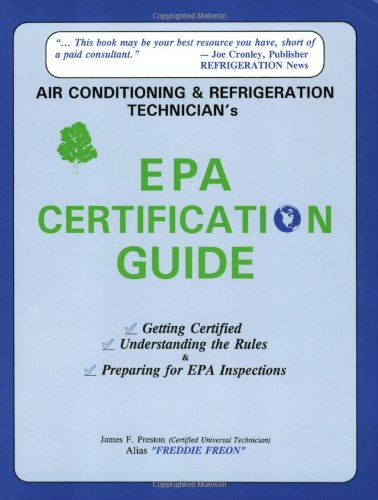

| EPA CERTIFICATION GUIDE James F. Preston Joe Cronley (fwd.) Moon Township, PA: D-AMP Publications, August 1994 |
Rating: 3.5 Fair |
|||
| ISBN-13 978-0-943641-10-2 | ||||
| ISBN-10 0-943641-10-1 | 192pp. | SC/LF/BWI | $29.95 | |
The years 1990 to 1994 were a time of transition for the HVAC industry in the U.S. A revision to the Clean Air Act, passed in 1990, made illegal the deliberate release to the atmosphere ("venting") of CFCs (chlorofluorocarbons) widely used in refrigeration and air conditioning. This followed on the heels of the Montreal Protocol, an international agreement aimed at reversing damage to Earth's ozone layer, which research had shown was caused by CFCs and other compounds containing chlorine. The U.S. signed this agreement in September 1987; it mandated that CFCs could no longer be manufactured after 1995.
"The U.S. ban on CFC propellants in spray cans caused a temporary pause in the growing demand for the offending compounds. But worldwide use of the chemicals continued, and levels of CFC production began to rise again. By 1985, the production rate was growing 3 percent a year." – Page 20 |
The 1990 revision to the Clean Air Act contained sections 608 and 609; these required that all technicians who serviced air conditioning or refrigeration systems using CFCs and related gases must be EPA certified by 14 November 1994. Hence this book and other guides to help technicians obtain the needed certification. (Section 608 pertains to fixed A/C and refrigerator equipment and to "MVAC-like" appliances. Section 609 pertains to MVACs; that is, to air-conditioners that cool the drivers and passengers in motor vehicles for on-road use.) I presume the distinction was made because of the great number of MVACs. AFAIK the book does not explain the reason for the different sections.
James F. Preston has done a fair job in producing the book. It is well laid out and easy to read. The information presented is accurate, for the most part. There are plenty of practice questions, with answers in the back of the book. Seven appendices present the applicable parts of the CFR (Code of Federal Regulations), lists of EPA hotlines and alternative refrigerants, and other useful information. Chapters 1 and 2 are excellent.1
However, I found too much repetitive and extraneous information. For example, pages 27-33 present a long list of dates to remember. These are not in chronological order, and most of them are not relevant to the test. (Having just taken a course on refrigerants and obtained universal Part 608 certification, I think I am able to make this assessment.) And then there is contradictory or incorrect information. See the Errata page for details on this. The bottom line for me is that I cannot regard this book as a trustworthy guide to passing the test.
In fairness, I must note that my instructor likes this book. Also, according to reviews there have been multiple reprints, the latest in 2004, which I have not seen. It is possible that these correct many of the deficiencies I found in the original edition.

 To contact Chris Winter, send email to this address.
To contact Chris Winter, send email to this address.